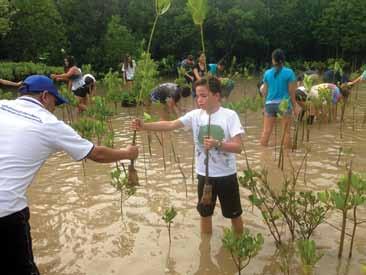
10 minute read
Service Learning
Service Learning >> Developing a Service Culture
It is widely recognized in international schools that service should not be seen as an add-on to an activities list or, even worse, a marketing tool to give prospective families an impression of caring or global awareness. In most schools service is now accepted as an integral part of the learning programme and something that students should be involved in. It has found its way into IB descriptors and CIS accreditation requirements and it is something that students and teachers expect to see and be involved in. But how do schools envelop it into their culture?
Yokohama International School has long had an active service programme. However, in recent years we have come to feel that it could be made stronger and a more recognised part of our school culture. With the support of the board of directors we made service a key area of focus for us as a school. We went back to the building blocks of our service programme and created a definition of service as well as a structured model to guide how we think about service at YIS and how we could build it into our learning programme. Although this was championed by a few, the design and creation of the model involved the whole faculty. This structure allowed us to look critically at what we were doing in our school and how we could develop and more thoroughly integrate it into the learning programme and culture of the school.
Our model for service is organised around specific roles and types of service, a cyclical process for engaging in service, and communities of interaction. The model is a way for us to ensure that the depth and integrity of the programme are at the highest possible level, the breadth of the programme provides opportunities for all members of our community to be involved, and, not least, we are addressing a real need in an authentic way.
The following points are things that have guided us in developing our service programme and which might be of help to you as you consider your school’s service programme:
1. Service is a K-12 programme; it is no longer the domain of only the older students in middle or high school. Students should be involved in service from the very start of their school career, so by the time they reach the older grades they have a good understanding of what service means and how they can be involved. 2. It must be integrated into the curriculum so it is seen as part of the learning programme. Our job as a school is to facilitate learning and if stu
dents are not learning from their service experiences then the service programme is not working. 3. Create a definition of service for the school; make sure everyone in the school community understands what service means to the school and how they can be part of it. 4. Service is not just posters and fundraising. Create an understanding that awareness, research, and advocacy are important, but action is the ultimate goal. 5. Get everyone in the community involved: include teachers, parents, neighbours, and local community groups. Service is a window to the greater community and a perfect vehicle to get outside people involved in the school and excited about what is happening there. 6. Service should be student-led wherever possible. Students will create real passion and drive for service projects, and their desire to take a lead will motivate the student body and develop leadership to a new level. 7. Create a service framework for the school that allows you to manage service in its different forms and also brings it into all facets of the school culture. 8. Ensure administration support; without this the programme will fall apart and will essentially be seen as an addition rather than a part of the school culture. 9. Ensure that any service is addressing a real need. It is easy for us to think we are doing something to help without really knowing the facts, so it is important to do your research and ask the right people. 10. Wherever possible, work with respected local non-governmental organisations (NGOs) rather than multinational charity groups. It is important that any service activity allows access to the people on the ground so you can do your research and due diligence, but also so your students are able to ask questions, see where the fruits of their labour is going, and, if possible, actually take part and provide active support. 11. Ensure a hierarchy of skills and expectations through the service programme. Tools such as Hart’s Ladder and Oxfam’s Levels of Complexity for Service can help in asking questions and guiding expectations of students. It is okay for a grade 1 class to want to do something to help the local stray cats, but there should be higher expectations on older students to not only do research in finding real needs but also understanding the causes and effects, and taking action to provide a solution. 12. Find a champion. Service is something that will create a groundswell in your school and once it is part of the culture, everyone is involved, but you need a champion to lead the way.
Service is a powerful element of any school programme and many international schools have invested time and energy into creating a programme for their community. However it is even more important that if you are going to have a complete and integrated service programme, then it is done not merely with the best intentions, but with the integrity that it provides your students with a rich learning opportunity while addressing identified real needs that exist all around us if we look carefully enough.
By Craig Coutts, Head of School Yokohama International School - Japan couttsc@yis.ac.jp

Modern learning spaces often reflect the way the students want to learn rather than traditional models of how teachers want to teach. 1 Modern learning spaces often reflect the way the students want to learn rather than traditional models of how teachers want to teach. 1
for designing modern learning environments for designing modern learning environments
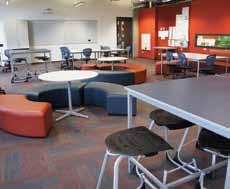


Furnware is a designer of innovative furniture for learning environments. Our research based and consultative approach ensures we create the best learning environments reflecting your pedagogy. I spend most of my time working in and with schools helping them make the transition from structured classrooms to spaces where modern pedagogies thrive. Having helped design hundreds of spaces, I have put together a list of my top 10 tips to help you think deeper about your spaces. Giving students’ choice in where they learn is a great way to help increase engagement Furnware is a designer of innovative furniture for learning environments. Our research based and consultative approach ensures we create the best learning environments reflecting your pedagogy. I spend most of my time working in and with schools helping them make the transition from structured classrooms to spaces where modern pedagogies thrive. Having helped design hundreds of spaces, I have put together a list of my top 10 tips to help you think deeper about your spaces. Giving students’ choice in where they learn is a great way to help increase engagement

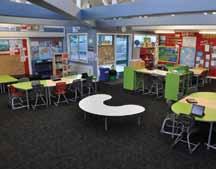
5Use specialised designs like the Kidney Table, Standing Height Tables and Kneeler Tables. 4 Start with a core table system that is flexible enough to adapt to the activities and group sizes you require.
5Use specialised designs like the Kidney Table, Standing Height Tables and Kneeler Tables. 4 Start with a core table system that is flexible enough to adapt to the activities and group sizes you require.
These designs provide work surfaces for specific activities at different heights. An innovative table design helps dictate how much movement you allow in the learning space. These designs provide work surfaces for specific activities at different heights. An innovative table design helps dictate how much movement you allow in the learning space.




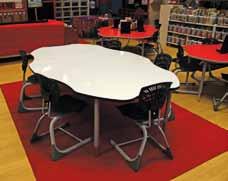
9Use efficient mobile storage systems to help define spaces. A whiteboard/pinboard on the back is useful as a teaching or display space. 8 Whiteboard table surfaces add incredible value to your learning spaces changing the way students learn and teachers teach.
9Use efficient mobile storage systems to help define spaces. A whiteboard/pinboard on the back is useful as a teaching or display space. 8 Whiteboard table surfaces add incredible value to your learning spaces changing the way students learn and teachers teach.


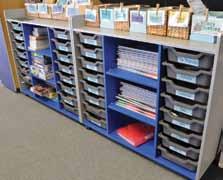

Storage systems should not be bulky or restrict flexibility in your spaces. Furnware’s Whiteboard tops can be designed to fit any table shape, size and height. Storage systems should not be bulky or restrict flexibility in your spaces. Furnware’s Whiteboard tops can be designed to fit any table shape, size and height.
2Modern learning spaces often reflect the way the students want to learn rather than traditional models of how teachers Yes, you can create a modern learning environment in traditional, single cell spaces.

3
Take note of where your students prefer to be in your existing spaces.
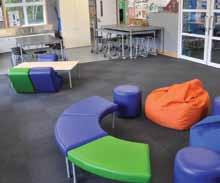
6Use specialised designs like the Kidney Table, Standing Height Tables and Kneeler Tables.
MLE design actually increases the usability and value of these spaces.


Once you have selected key pieces for the formal spaces, adding soft furniture will create more informal spaces providing fun, color and texture.
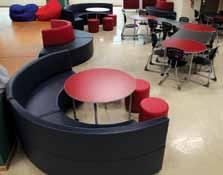


Make sure some of these soft furnishings also work with the tables, giving you ultimate flexibility.
10 Use efficient mobile storage systems to help define spaces. A whiteboard/pinboard on the back is useful as a teaching or display space. Choosing the right color system will help set the tone of the learning space.
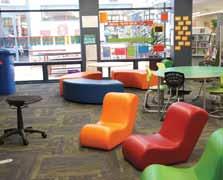


Are you looking to promote energy and fun or create a calm space where students require more focus?
Do they like to lay on the floor, stand at a bench, work by themselves, or work in a group?


7
Consider replacing your teachers’ desk with a Teachers Pod. It’s a mobile teaching workspace, storage, teaching and conversation post.
A Teachers Pod can increase the area of your learning space by up to 15%.


Based in Singapore, I manage Furnware’s SE Asia market. I would be delighted to assist you in your journey to create amazing learning spaces.
Grant van der Kruk +65 8181 3178 grantv@furnware.com.sg Twitter: @grant_vdk www.furnware.com.sg










